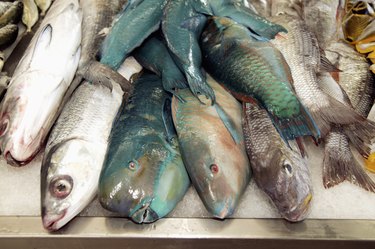
Much of the food consumed in the United States is imported, including an estimated 60 percent of fresh fruits and 80 percent of seafood, according to a March 2011 article in Scientific American. Before January 2011, the U.S. Food and Drug Administration possessed limited authority to impose U.S. standards on foreign suppliers. However, tougher laws aimed at preventing outbreaks of food-borne illness have strengthened its monitoring and enforcement capability over both offshore food suppliers and domestic importers.
Food-Borne Illness and Deaths
Video of the Day
Statistics released in April 2011 by the Centers for Disease Control and Prevention estimate that 47.8 million food-borne illnesses occur annually in the United States, 127,839 requiring hospitalization and 3,037 causing death. However, these numbers were challenged in an editorial published in the Feb. 23, 2011, "New England Journal of Medicine," charging that changes in the CDC's data collection methods had produced misleadingly low figures. Actual rates had been "stagnant" since 1999, when an estimated 76 million illnesses, 325,000 hospitalizations and 5,000 deaths were attributed to tainted food, wrote Michael Osterholm, director of the University of Minnesota's Center for Infectious Disease and Research Policy.
Video of the Day
Demand Fuels Supply
As food tastes become more international, consumer demand for imported food products, especially those used in Asian cuisines, has increased. Food from countries where labor and production costs are a fraction of those in the United States may often be cheaper than domestically produced counterparts and also impart a more authentic taste to dishes, but there's a downside. When quality control and production standards aren't up to U.S. standards, the chances of food-borne illnesses increase. If inspectors don't catch unsafe products before they end up on grocery store shelves, news only gets out after people who have eaten them contract food poisoning.
China: An Ongoing Concern
In 2007, Dr. David Acheson, the FDA's associate commissioner on foods, testified before a committee of the U.S. House of Representatives that the FDA had a "history of concern" about substandard and tainted food exports from China. Among the incidents that prompted a spate of alerts and recalls were pet foods and livestock feed contaminated with the industrial chemical melamine, along with repeated discoveries of fish and seafood that contained residues of illegal drugs, food additives and chemical contaminants. In April 2008, Jean M. Halloran, director of food policy initiatives for Consumers Union who was speaking to a government commission, said, "We have considerable evidence that seafood imports from China pose significant safety risks." The FDA's ability to stop unsafe food from entering the country was "very limited," Halloran said.
Food Safety Modernization Act
The $1.4 billion Food Safety Modernization Act, signed into law by President Barack Obama in January 2011, seeks to reduce outbreaks of food-borne illness by imposing stricter regulations on food imports and expanding the FDA's enforcement authority. The new regulations require domestic importers to assume responsibility for the safety of food from their foreign suppliers and for offshore food processors to institute measures to prevent contamination. Under FSMA laws, the FDA has been empowered to block foods from noncompliant facilities or countries from entering the United States. Under old laws, the FDA had to persuade businesses to voluntarily recall food products deemed unsafe, but new laws confer unilateral authority to order recalls.
- U.S. Department of Health and Human Services; Testimony of Dr. David Acheson Before U.S. House of Representatives; 2007
- U.S.D.A. Economic Research Service; Imports from China and Food Safety Issues; Fred Gale and Jean C. Buxby; July 2009
- Centers for Disease Control and Prevention: 2011 Estimates of Foodborne Illness in the U.S.; April 2011
- Scientific American; Earth Talk; Easier to Swallow: U.S. Beefs Up FDA...; March 11, 2011